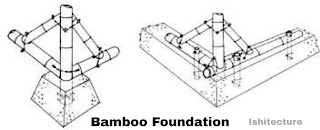Achyut Kanvinde-The Functionalist Architect


The regions
traditionally associated with the use of bamboo as a building material are
South and East Asia, South Pacific and Central and South America. In China and
India, bamboo was used to holding up simple suspension bridges by making cables of
split bamboo or twisting whole culms of bamboo together. In Japanese
architecture, it was used as supplemental and/or decorative elements like
fencing, fountains, grates and gutters. To date, most high profile bamboo
construction projects are in Vietnam, Bali, China and Columbia.
· FOUNDATIONS

1.
Bamboo
in-direct ground contact
2.
Bamboo
on rock or perforated concrete footings
3.
Bamboo
incorporated into concrete footings
4.
Composite
bamboo/ concrete columns
5. Bamboo piles
· FLOORING

1. Small bamboo culms
2. Split bamboo
3. Flattened bamboo
4. Bamboo mats
5. Bamboo plastic composites
· WALLS - The different varieties are as follows:
·
· SCAFFOLDING - Due
to the favourable relationship between load-bearing capacity and weight, bamboo
is used as scaffolds in the buildings.
· Due to the high residual strength of bamboo to absorb shocks and impacts and the flexure coupled with its very low mass, bamboo is resistant to earthquakes.
· A bamboo house withstood an earthquake that occurred at Sikkim measured 6.9 in September 2011.
· 30 houses at the epicentre of a 7.6 magnitude earthquake survived without any damage in Costa Rica in 1991.
· Strength – Bamboo
is an extremely strong natural fibre, when cultivated, harvested and stored
properly.
· Flexibility –
Bamboo is highly flexible and can be bent and used in arches and other curved
structures.
· Earthquake resistance – It has a great capacity for shock absorption, which makes it
particularly useful in earthquake-prone areas.
· Lightweight –
As bamboo is lightweight, construction with it requires simple tools and is
accomplished faster.
· Cost-effective – It is economical, especially where it is cultivated and the
transportation cost is also less.
· Durability –
It is long-lasting when harvested and maintained properly.
· Joining techniques – A number of traditional joineries exist, but their structural efficiency
is low, thus considerable research is being done for the development of more
effective methods.
· Flammability – it
is not fire-resistant, and the cost of treatment is quite high.
Bamboo has been the backbone of much of the world’s rural life and will
remain so as the population increases. Due to the increase in interest towards
bamboo as a building material, many architects and builders like Simon Velez,
Marcelo Villegas, Oscar Hidalgo – Lopez, John Hardy etc. The high-value
utilization of bamboo will not only promote economic development but also
saves forest resources to protect our ecological environment as a wood
substitute.


Very informative....
ReplyDeleteThank You.
DeleteGood
ReplyDeleteU got good knowledge